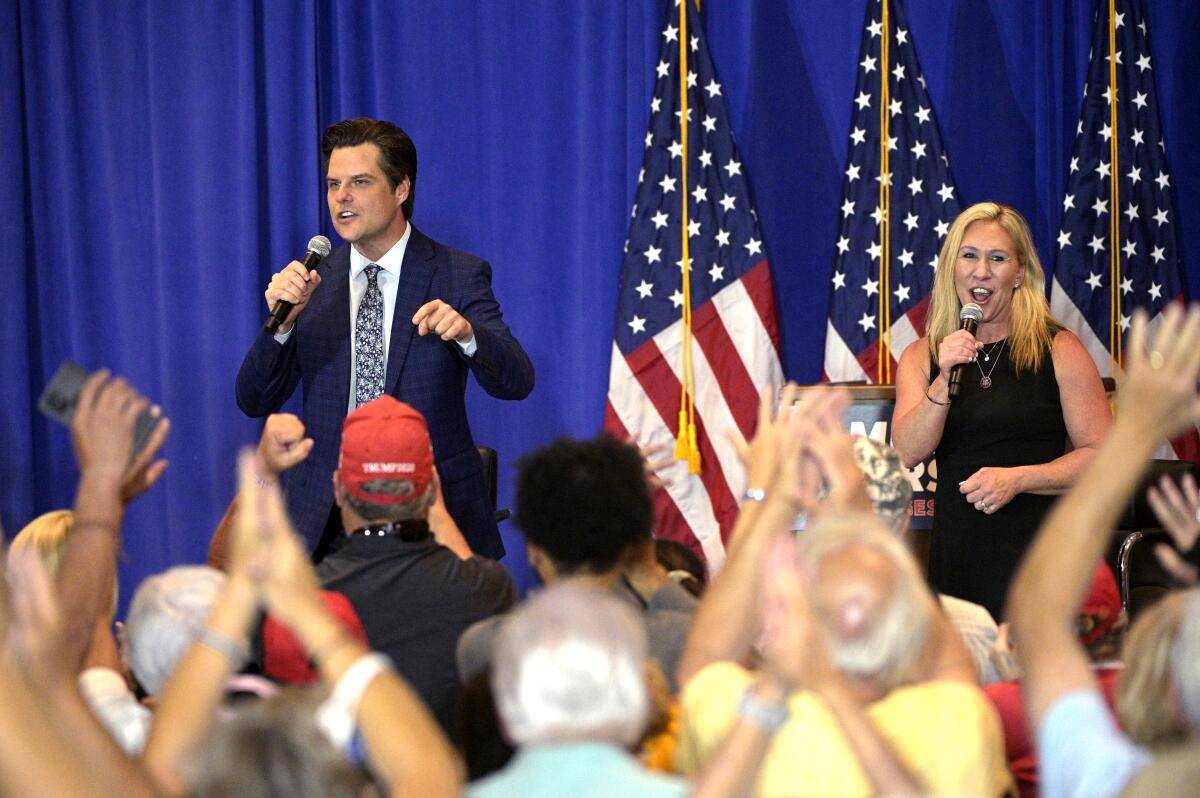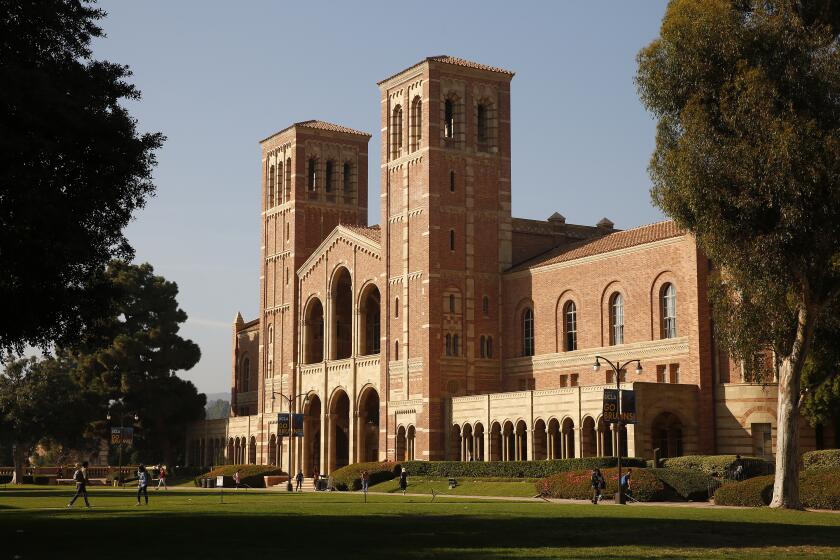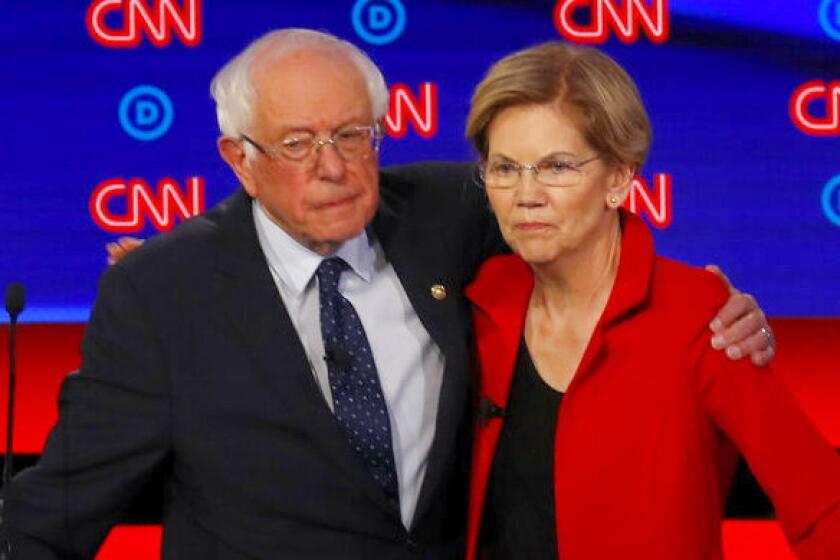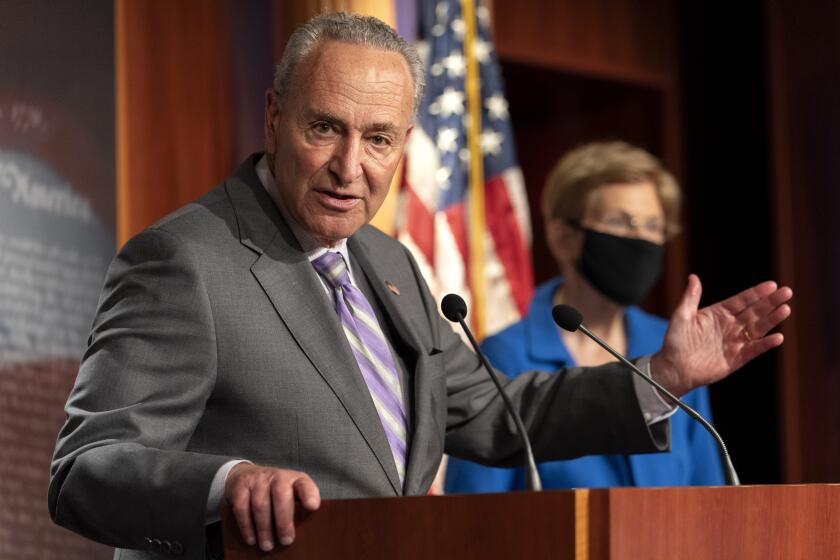Column: GOP ratchets up the hypocrisy in opposing Bidenâs student debt plan

The hypocrisy meter has been stuck at the high end as Republicans and conservatives fill the airwaves and social media to decry President Bidenâs student loan forgiveness proposal.
Now they have something else to grouse about: The White House has been gleefully pointing out on Twitter that many of those going public with complaints about forgiving $10,000 or $20,000 in student debt had themselves gotten federal COVID relief loans forgiven â often for sums in the hundreds of thousands of dollars, or even more than a million.
For example, the White House Twitter feed paired the statement from congressional performance artist Rep. Marjorie Taylor Greene (R-Ga.) that âfor our government just to say ok your debt is completely forgiven.. itâs completely unfair,â with the observation that Greene received forgiveness for $183,504 in COVID relief loans.
âItâs galling to hear many refer to borrowers as slackers. These are typically people from lower-income families...using their income to help their families as well as pay down their own debt. Slackers?â
— Bharat Ramamurti, National Economic Council
The White Houseâs tweets arenât unique. Twitter has been filling up with tweets from others that juxtapose a politicianâs criticism of the Biden proposal with an entry from ProPublicaâs indispensable database of loans from the governmentâs Paycheck Protection Program, or PPP, showing how much forgiveness each politico received, along with the sarcastic caption, âThis you?â
This skewering is amusing, in its way, but is it fair? Defenders of the Republican critics assert that itâs not. The Paycheck Protection Program, they observe, was enacted specifically as a bulwark against a pandemic-related economic crash.
Get the latest from Michael Hiltzik
Commentary on economics and more from a Pulitzer Prize winner.
You may occasionally receive promotional content from the Los Angeles Times.
Loan forgiveness was baked into the program from the start, they add: Borrowers were told their loans would be forgiven if they used the money to keep their workers employed during COVID shutdowns or for utilities or rent.
Thatâs true, but irrelevant for several reasons. One is that much of the criticism coming from GOP officeholders or other conservatives has nothing to do with what the loans are used for. The critics are making a categorical assertion that repaying borrowed money is a duty, no matter what.
The House Judiciary Committeeâs GOP minority, for instance, used its Twitter account to state, baldly: âIf you take out a loan, you pay it back. Period.â
(The liberal Center for American Progress Action Fund mischievously used its Twitter account to pair that tweet with its own list of 13 Republican lawmakers who received a total of $17.6 million in PPP forgiveness, captioned, âWhatâs that about paying loans back?â)
The defenders also argue that PPP was designed for an urgent public purpose. But who says that student loans are not designed for an urgent public purpose â that is, to expand the accessibility of higher education, which is widely regarded as a public good, to millions of Americans who might be denied it because of its cost?
Forgiveness has also been baked into the student loan program through income-driven repayment plans, which were first implemented in 1994, almost 30 years ago. Income-driven repayment programs limit student borrowersâ repayments to a percentage of their annual income, typically 10%. After 10 to 25 years of repayments, the remaining loan balances are, yes, forgiven.
These programs are âde facto student debt cancellation,â Marshall Steinbaum, a higher education finance expert at the Jain Family Institute, told me earlier this year. Why not bite the bullet and cancel the debt now?
With income-driven repayment, âthe alternative to canceling student debt is to wait 20 years and then cancel it after youâve ruined someoneâs life,â Steinbaum says. âThe governmentâs not going to be repaid either way.â
Who paid for the college education for GOP critics of Bidenâs student loan relief? The taxpayers, thatâs who.
The income-driven repayment option hasnât been taken up by as many borrowers as could benefit, but that may now change. Bidenâs program makes it more advantageous by cutting the annual obligation to 5% of income and ensuring that the forgiven portion of the loans is not treated as taxable income, as are forgiven loans in other contexts.
That brings us to the fundamental hypocrisy underlying criticisms of Bidenâs student loan relief proposals: This is the notion that borrowers have a moral duty to repay their debt, come hell or high water.
Superficially, that sounds right. Itâs tied in with the strictures against stealing and lying that date back at least to the Ten Commandments. In practice, however, itâs hogwash.
We know this because debt forgiveness is embedded in our entire credit system.
The higher interest rates that some borrowers pay on their loans than others reflects lendersâ judgments about the prospects that the borrowers will default or that their collateral will be insufficient to cover the defaulted balance, or both. If the moral obligation to pay oneâs debts were a hard and fast rule, then everyone would pay the same rate.
Obviously, itâs not illegal to default on a loan, or there would be more borrowers in prison than drug dealers.
The crime is to obtain a loan by lying about oneâs intention to repay or about oneâs financial condition. Thatâs not at issue with student loans: Since the borrowers typically expect to pay them off, theyâre not required to post collateral, and their credit histories donât determine their interest rate.
Is canceling student debt inflationary? No, itâs good for the economy.
Debt forgiveness is also implicit in our bankruptcy system, which is specifically designed to give borrowers a fresh start by eradicating all or part of their debt. Republicans who are unclear about this should ask the putative head of their party, Donald Trump, who placed six of his properties into bankruptcy from 1991 to 2009.
Trumpâs own business partners helpfully listed those cases in a disclosure statement filed with the Securities and Exchange Commission this year.
The partners specified bankruptcies filed by the Trump Taj Mahal in 1991; the Trump Plaza, Trump Castle, and Plaza Hotel in 1992; Trump Hotels and Casino Resorts in 2004; and the same company, renamed Trump Entertainment Resorts, in 2009.
The disclosure also noted that a seventh venture, Trump Shuttle, which Trump founded in 1989, âdefaulted on its loans in 1990 and ceased to exist by 1992.â
As it happens, student loans are in the small category of loans that cannot be discharged â that is, eradicated â in Bankruptcy Court.
This should never have happened. Itâs the result of a panic over student loan defaults starting in the 1970s that was never supported by any actual data.
Starting in 1976, student loans were rendered ineligible for bankruptcy discharge in their first five years. In 1990, the five-year limit was extended to seven years, and in 1998 eliminated, making the loans ineligible for bankruptcy relief entirely. The only exception is for âundue hardship,â which is undefined in the law and seldom invoked.
âSomewhat like the stories of mothers on public assistance riding in Cadillacs to buy steaks with food stamps,â Deanne Loonin of the National Consumer Loan Center reported in 2006, âstories of doctors making big bucks discharging their hefty student loans caught the attention of Congress, the media, and the public.â
Those yarns were never authenticated, however. In fact, the Government Accountability Office determined in 1978 that although the default rate on student loans was 18%, less than 4% of the amounts borrowed were discharged in bankruptcy, resulting in an overall discharge rate of less than three-quarters of 1%, better than the rate on other consumer loans.
Making student loans dischargeable in bankruptcy isnât part of Bidenâs package, but is the focus of advocates intent on carrying Bidenâs reforms forward.
Another claim made by critics of the Biden plan demands to be addressed. The claim is that student debt relief will chiefly benefit wealthy families or borrowers who wonât have any difficulty paying their loans without help, such as future doctors, lawyers and business school graduates. The hard numbers expose this claim as nonsense.
MBA graduates accounted for 2.6% of all student loan borrowers who received their degrees in 2015-16, lawyers were 1% and doctors 0.5%, according to statistics released by the Department of Education in 2020. That means that about 4% of all borrowers fell into those high-profile, well-paid career categories.
Canceling student debt isnât unfair to those who have already paid off their loans. And it isnât a giveaway to the rich, either.
Will they be laughing all the way to the bank? Doubtful. âClearly a significant portion of them will be excluded from reliefâ by the income cap of $125,000 imposed by the Biden program on recipients of debt forgiveness, Bharat Ramamurti, deputy director of the National Economic Council, a White House adjunct, observed on Twitter.
Who will get the greater benefit from forgiveness? As Ramamurti observes, itâs the borrowers who receive Pell Grants, federal stipends aimed at lower-income students. Theyâll be eligible for $20,000 in forgiveness, twice the sum provided for other borrowers within the income cap.
Pell Grant recipients account for 27 million student loan borrowers, or 60% of the total, Ramamurti says. Nearly all come from families with less than $60,000 in annual income.
âThis is why itâs galling to hear many refer to borrowers as slackers,â Ramamurti adds, referring to a theme popular among Republicans and conservatives asserting that working Americans will be shouldering the debt for these freeloaders. âThese are typically people from lower-income families ... trying to get a degree, and then using their income to help their families as well as pay down their own debt,â Ramamurti counters. âSlackers?â
Itâs well past time for the critics of student debt relief to get honest about their real purpose. Itâs to protect wealthier Americans who fear their income taxes will have to rise to pay for that relief. Bidenâs plan may be the most significant reversal of the flow of government resources in years, following a long period in which the rich saw their tax rates plummet while those of almost everyone else rose.
As UC Berkeley economists Emmanuel Saez and Gabriel Zucman noted in their 2019 book, âThe Triumph of Injustice,â and on their website taxjusticenow.org, the federal tax rate of the richest 10% of American households fell from 32.6% of pretax income in 1950 to 27.5% in 2018. The rate of the bottom 90% rose from 22.1% to 29%, and of the bottom 20% from 16.3% to 24.6%.
One heard not a peep from todayâs student relief critics about the cost of the 2017 tax cuts signed by President Trump, which overwhelmingly benefited rich people, or about the cost of standard tax breaks enjoyed principally by wealthy people, such as the preferential tax rate on capital gains.
These are breaks worth hundreds of thousands or millions of dollars to their recipients. Theyâre paid by working families that get no benefit from them. Think of that the next time you hear the water carriers for the rich in Congress complain about a break worth $20,000 or less to more than 40 million working Americans.
More to Read
Get the latest from Michael Hiltzik
Commentary on economics and more from a Pulitzer Prize winner.
You may occasionally receive promotional content from the Los Angeles Times.














